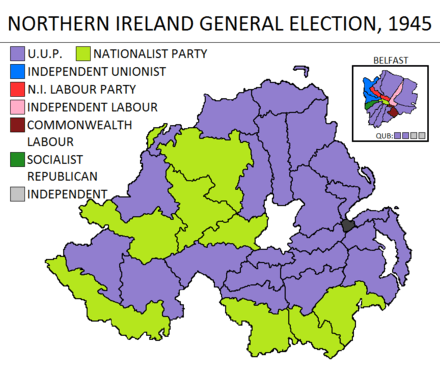1945 Northern Ireland general election
The 1945 Northern Ireland general election was held on 14 June 1945. The election saw significant losses for the Ulster Unionist Party, though they retained their majority.
| ||||||||||||||||||||||||||||||||||||||||||||||||||||||||||||||||||||||||||||||||||
All 52 seats to the House of Commons of Northern Ireland 27 seats were needed for a majority | ||||||||||||||||||||||||||||||||||||||||||||||||||||||||||||||||||||||||||||||||||
|---|---|---|---|---|---|---|---|---|---|---|---|---|---|---|---|---|---|---|---|---|---|---|---|---|---|---|---|---|---|---|---|---|---|---|---|---|---|---|---|---|---|---|---|---|---|---|---|---|---|---|---|---|---|---|---|---|---|---|---|---|---|---|---|---|---|---|---|---|---|---|---|---|---|---|---|---|---|---|---|---|---|---|
| ||||||||||||||||||||||||||||||||||||||||||||||||||||||||||||||||||||||||||||||||||
 Percentage of seats gained by each of the party | ||||||||||||||||||||||||||||||||||||||||||||||||||||||||||||||||||||||||||||||||||
| ||||||||||||||||||||||||||||||||||||||||||||||||||||||||||||||||||||||||||||||||||
Northern Ireland 1921–1972
|
|---|
| This article is part of a series on the politics and government of Northern Ireland 1921–1972 |
|
Government
|
|
Mirroring the result across the rest of the UK in the 1945 UK general election, candidates standing on behalf of the various Labour parties won a significantly higher vote share of 30%,[nb 1] but this translated into just two new MPs due to the first-past-the-post electoral system.
Results
| 33 | 10 | 2 | 2 | 5 |
| UUP | Nationalist | L | IU | Oth |
| 1945 Northern Ireland general election | |||||||||||||||
|---|---|---|---|---|---|---|---|---|---|---|---|---|---|---|---|
| Party | Candidates | Votes | |||||||||||||
| Stood | Elected | Gained | Unseated | Net | % of total | % | No. | Net % | |||||||
| UUP | 41 | 33 | 0 | 6 | -6 | 63.5 | 50.4 | 180,342 | -6.4 | ||||||
| NI Labour | 15 | 2 | 2 | 1 | +1 | 3.8 | 18.5 | 66,053 | +12.8 | ||||||
| Nationalist | 11 | 10 | 2 | 0 | +2 | 19.2 | 9.1 | 32,546 | +4.2 | ||||||
| Commonwealth Labour | 6 | 1 | 1 | 0 | +1 | 1.9 | 7.8 | 28,079 | N/A | ||||||
| Independent Unionist | 5 | 2 | 1 | 1 | 0 | 3.8 | 5.0 | 17,906 | -1.8 | ||||||
| Communist (NI) | 3 | 0 | 0 | 0 | 0 | 3.5 | 12,456 | N/A | |||||||
| Independent Labour | 2 | 1 | 0 | 0 | 0 | 1.9 | 2.8 | 9,872 | +1.1 | ||||||
| Socialist Republican | 2 | 1 | 1 | 0 | +1 | 1.9 | 1.5 | 5,497 | N/A | ||||||
| Federation of Labour | 1 | 0 | 0 | 0 | 0 | 1.1 | 3,912 | N/A | |||||||
| Independent | 2 | 2 | 2 | 0 | +2 | 3.8 | 0.3 | 1,219 | -1.9 | ||||||
Electorate: 845,964 (509,098 in contested seats); Turnout: 70.3% (357,882).
Votes summary
Seats summary
Footnotes
- 19% for the Northern Irish Labour Party, 8% for the Commonwealth Labour Party, 3% for Independent Labour candidates and 1% for the Federation of Labour
gollark: Mathematics is behind SO MANY USEFUL THINGS.
gollark: HERESY
gollark: They can make shelter and stuff using the Banach-Tarski paradox.
gollark: Mathematicians, in fact, require no worldly posessions, because they feed themselves by proving that they have food and water.
gollark: But they're hoarding their arbitrarily powerful computers and infinitely large RAM chips!
See also
This article is issued from Wikipedia. The text is licensed under Creative Commons - Attribution - Sharealike. Additional terms may apply for the media files.